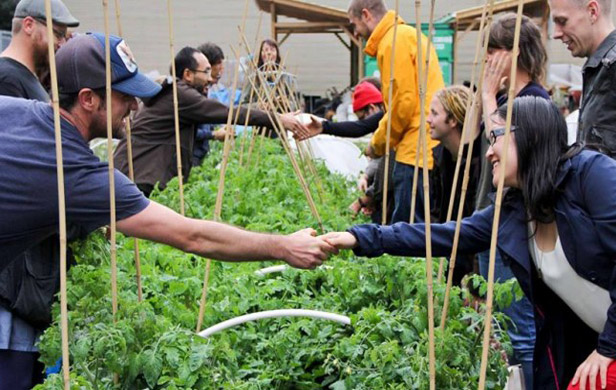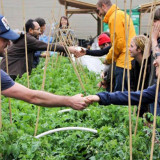
“Make no little plans. They have no magic to stir men’s blood and probably will not themselves be realized.” That was American architect Daniel Burnham’s city-planning advice at the turn of the 20th century.
More than 100 years later, he couldn’t be more wrong. Big, top-down building projects no longer stir the imaginations of North American city dwellers. Now people are excited about little changes to our urban fabric.
Small projects sprout up through cracks of urban landscape
Small, creative projects that make cities more livable are popping up in unexpected places: alleys, front yards, vacant lots and parking spaces. Whether its yarn-bombed street furniture, roadway parking turned to mini-parkettes or guerrilla gardens in overlooked spaces, these often-unauthorized interventions are helping to transform properties and neighbourhoods, one light, quick, cheap tweak at a time.
Last spring, residents of Toronto’s Palmerston Square took note when an old chalkboard suddenly appeared on a tall, rusted schoolyard fence that runs along their quiet residential street — the first salvo from two participants in the David Suzuki Foundation’s Homegrown National Park Project.
Passersby were encouraged to write their desires for green improvements. Neighbours began meeting. One family filled a perpetual pothole with flowers. Others put benches in their front yards to begin “parkifying” the block. Graffiti knitters yarn-bombed the chain-link fence. An artist and local kids created a DIY outdoor version of fridge magnet poetry with plastic pipes cut in half, painted with words and hung on the fence with simple S-hooks. Two garden planters were dug into spots where trees had perished.
From asphalt to bee haven
This spring, residents successfully funded a project to replace the entire stretch of asphalt with a large pollinator-friendly garden. There’s even talk of removing the fence. The ripple effect: People from nearby streets have started organizing their own interventions, like a pollinator garden at the neighbourhood daycare and moss graffiti in an alleyway. As resident Anjum Chagpar said, “Inspiration breeds inspiration. Simple, fun interventions are contagious.”
Replacing pavement with a pollinator garden on one small street won’t solve the vast issues our communities face, but little spaces perhaps hold the greatest potential. To make our cities truly green, we must bring nature to the oft-neglected bits between parks and existing green areas. Streets and sidewalks alone account for about 80 per cent of a city’s public space. Private spaces like yards, rooftops and balconies cover more than half the urban landscape. Stretching our visions of urban green space to include these allows us to reimagine the city as a vibrant green mosaic.
Homegrown Design Challenge
Squeezing more nature into cities requires creativity. It also needs buy-in from homeowners, property managers and experts from fields like landscape architecture and urban planning.
That’s why the David Suzuki Foundation and Workshop Architecture launched the Homegrown Design Challenge, an open competition that provides an opportunity to present ideas for low-cost, easy-to-implement landscape design solutions for front yards, backyards, balconies, schoolyards and laneways that provide environmental benefits, like capturing storm-water during severe weather events and providing habitat for birds, bees and butterflies.
“While we expect interest from architects, landscape architects, designers and planners, the competition is open to anyone with innovative green design ideas,” said Helena Grdadolnik, Workshop Architecture competition organizer.
Daniel Burnham lived in a time when telegrams were cutting-edge. Today good ideas can spread from community to community across the globe almost instantaneously.
Growing design ideas
So it’s no surprise that a growing number of design competitions and events are celebrating urban interventions, from PARK(ing) Day, which highlights the transformation of parking spots into temporary public spaces in 35 countries, to 100-in-1 Day, which will be held this year on June 7 in Toronto, Halifax and Vancouver to celebrate citizen-led initiatives that “raise awareness of urban and social issues, inspire ideas, and motivate leaders to consider new approaches to old problems.”
If a project requires start-up dollars, crowd-funding websites help organizers raise money in mere days or weeks. Sites like Projexity.com enable groups and individuals to fund, design and build projects in their neighbourhoods.
What can we take from this revolutionary wave of small, creative interventions? That residents can play an active, hands-on role in transforming the places they live, work, play and share. Making your community truly greener is a tall order. But starting small can pay big dividends.
With contributions from David Suzuki Foundation Homegrown National Park Project lead Jode Roberts.

